Structural Assessment of Historical Stone Bridges with the Finite Element Method under Dynamic Effects of Arch Shape: The Antik Iscehisar Bridge
Abstract
:1. Introduction
2. Description of the Historical One-Span Afyon İscehisar Bridge
3. Modeling
3.1. Component Forms
3.2. Interaction Forming
3.3. Material Model and Border Situations
4. Ground Motions
5. Live Load Analysis
6. Results
7. Conclusions
- It was observed that the displacements increased as the arch height decreased under the bridge’s own weight. Max. displacements occurred at the arch opening;
- As the arch height of the bridge decreased, the tensile stress on the bridge increased. Tensile stresses occurred in the tempan wall in the analyses with a belt height of 879 cm and in the balustrade in the analyses with a belt height of 779 cm. As the belt height decreased, the compressive stress increased;
- Compressive stresses were formed in the regions where the arch foot was supported on the ground. The displacement, tensile stress, and compressive stress increased curves with the decrease in arch height of the bridge under its own weight;
- When the compressive stress values obtained as a result of the earthquake analyses applied to the bridge were examined, it was observed that the min. compressive strength of the bridge material, 20 MPa, was not exceeded. For this reason, no damage due to the pressure stress value was observed in the earthquake analyses applied to the bridge;
- When the max. principal tensile stresses resulting from the earthquake analyses applied to the bridge were examined, it was detected that the tensile stress of the bridge material, 1 MPa, exceeds the tensile stress value in two earthquake accelerations for ten different earthquake accelerations examined;
- Tensile stress values showed risk for Landers and Northridge earthquakes in the analyses. These two earthquake accelerations may pose a risk of damage to the bridge. Potential damage areas for the Landers and Northridge earthquakes were expected to occur in areas where the pier is supported on the ground.
Author Contributions
Funding
Institutional Review Board Statement
Informed Consent Statement
Data Availability Statement
Conflicts of Interest
References
- Hasol, D. Ansiklopedik Mimarlık Sözlüğü, 2nd ed.; Sıralar Matbaası: İstanbul, Turkey, 1979; p. 560. [Google Scholar]
- Available online: http://www.silvan.gov.tr/malabadi-koprusu (accessed on 19 December 2022).
- Drosopoulos, G.; Stavroulakis, G.; Massalas, C. Influence of the geometry and the abutments movement on the collapse of stone arch bridges. Constr. Build. Mater. 2008, 22, 200–210. [Google Scholar] [CrossRef]
- Beyer, L. Arched Bridges. Master’s Thesis, University of New Hampshire, Durham, UK, 2012; p. 78. [Google Scholar]
- Pelà, L.; Aprile, A.; Benedetti, A. Seismic assessment of masonry arch bridges. Eng. Struct. 2009, 31, 1777–1788. [Google Scholar] [CrossRef]
- Wu, L. Serviceability Assessments of Masonry Arch Bridges. Ph.D. Thesis, Cardiff University, Cardiff, Wales, 2010; p. 248. [Google Scholar]
- Zhang, Y. Advanced Nonlınear Analysıs of Masonry Arch Brıdges. Ph.D. Thesis, Imperial College Londra, London, UK, 2015; p. 293. [Google Scholar]
- Yılmaz, B. Tarihi Köprülerin Yapısal Davranışına Kemer Geometrisinin Etkisi. Master’s Thesis, Karadeniz Teknik Üniversitesi, Trabzon, Turkey, 2016; p. 63. [Google Scholar]
- Ahmad, S.H.S. Static Analysis of Masonry Arches. Ph.D. Thesis, University of Salford, Salford, UK, 2017; p. 155. [Google Scholar]
- Özmen, A.; Sayın, E. Linear Dynamic analysis of a masonry arch bridge. In Proceedings of the International Conference on Innovative Engineering Applications (CIEA’ 2018), Sivas, Turkey, 20–22 September 2018; pp. 1–7. [Google Scholar]
- Gönen, S. Relıabılıty- Based Seısmıc Assessment of Masonry Arch Brıdges. Ph.D. Thesis, Boğaziçi University, İstanbul, Turkey, 2020; p. 217. [Google Scholar]
- Akın, K. Tarihi Yığma Köprülerin Farklı Sönüm Oranları Altında Sismik Tepkisinin Değerlendirilmesi. Master’s Thesis, Fırat Üniversitesi, Elazığ, Turkey, 2020; p. 72. [Google Scholar]
- Rahimi, A.; Aval, S.B.B.; Noori, M.; Sarhosis, V.; Wu, Z.; Nikkhoo, A.; Altabey, W.A. A simplified beam model for the numerical analysis of masonry arch bridges—A case study of the Veresk railway bridge. Structures 2022, 45, 1253–1266. [Google Scholar] [CrossRef]
- Addessi, D.; Gatta, C.; Nocera, M.; Liberatore, D. Nonlinear Dynamic Analysis of a Masonry Arch Bridge Accounting for Damage Evolution. Geosciences 2021, 11, 343. [Google Scholar] [CrossRef]
- Yilmaz, E.G.; Sayin, E.; Özmen, A. Dynamic Analysis of Historical Masonry Arch Bridges under Different Earthquakes: The Case of Murat Bey Bridge. Turk. J. Sci. Technol. 2022, 17, 461–473. [Google Scholar] [CrossRef]
- Bozyigit, B.; Acikgoz, S. Dynamic amplification in masonry arch railway bridges. Structures 2022, 45, 1717–1728. [Google Scholar] [CrossRef]
- Sakcalı, G.B.; Gönül, A.; Bağbancı, M.B.; Yüksel, I. Linear/Nonlinear Dynamic Analysis and Prediction of Failure Mechanism of Irgandi Bridge. Period. Polytech. Civ. Eng. 2022, 66, 1248–1261. [Google Scholar] [CrossRef]
- Özodabaş, A.; Artan, C. Determination of Stress and Deformation Zones of Historical Mus Murat Bridge. Bilecik Şeyh Edebali Üniversitesi Fen Bilim. Derg. 2021, 8, 413–429. [Google Scholar] [CrossRef]
- Nemutlu, F.; Güzel, I.; Balun, B.; Öztürk, M.; Sari, A. Nonlinear Seismic Assessment of Historical Masonry Karaz Bridge Under Different Ground Motion Records. Bitlis Eren Üniversitesi Fen Bilim. Derg. 2023, 12, 247–260. [Google Scholar] [CrossRef]
- Zampieri, P.; Santinon, D.; Piazzon, R.; Hofer, L.; Toska, K.; Faleschini, F.; Pellegrino, C.; Ricci, D.; Iodice, F.; Vecchi, A.; et al. Intrados CFRCM strengthening of masonry arches. Procedia Struct. Integr. 2023, 44, 926–933. [Google Scholar] [CrossRef]
- Aktürk, K.K. Afyonkarahisar Bölgesi Tarihi Taş Köprülerinin Mimari ve Statik Özellikleri. Master’s Thesis, Afyon Kocatepe Üniversitesi, Afyonkarahisar, Turkey, 2019; p. 147. [Google Scholar]
- Available online: https://www.google.com/maps/@39.4329458,33.6926132,804307m/data=!3m1!1e3?entryttu (accessed on 1 June 2020).
- ANSYS. 1998. Available online: https://www.ansys.com/ (accessed on 1 June 2020).
- Karalar, M.; Yeşil, M. Effect of near-fault earthquakes on a historical masonry arch bridge (KonjicBridge). Earthq. Struct. 2021, 21, 125–136. [Google Scholar] [CrossRef]
- Karalar, M.; Yeşil, M. Structural Investigation of a Historical Masonry Arch Bridge under Far-Fault Earthquakes. Teh. Vjesn.—Tech. Gaz. 2023, 30, 1443–1450. [Google Scholar] [CrossRef]
- Jebur, A.K.; Khan, I.; Nath, Y. Numerical and Experimental Dynamic Contact of Rotating Spur Gear. Mod. Appl. Sci. 2011, 5, 254. [Google Scholar] [CrossRef]
- Kadhim, M.M.A. Factors effect on the effective length in a double strap joint between steel plates and CFRP. Int. J. Adv. Appl. Sci. 2012, 1, 11–18. [Google Scholar]
- Makris, N.; Chang, S. Effect of Damping Mechanisms on the Response of Seismically Isolated Structures; PEER-98/06; Pacific Earthquake Engineering Research Center: Berkeley, CA, USA, 1998. [Google Scholar]
- Makris, N.; Black, C.J. Evaluation of Peak Ground Velocity as a “Good” Intensity Measure for Near-Source Ground Motions. J. Eng. Mech. 2004, 130, 1032–1044. [Google Scholar] [CrossRef]
- Ünay, A.İ. A Method for the Evaluation of the Ultimate Safety of Historical Masonry Tructures. Doctoral Thesis, Ortadoğu Teknik Üniversitesi, Ankara, Turkey, 1997; p. 261. [Google Scholar]
- Kazaz, I.; Kocaman, I. Taş yığma camilerin sismik yük kapasitelerinin değerlendirilmesi. Gazi Üniversitesi Mühendislik Mimar. Fakültesi Derg. 2018, 2018, 557–574. [Google Scholar] [CrossRef]
- Sevim, B.; Bayraktar, A.; Altunişik, A.C.; Atamtürktür, S.; Birinci, F. Assessment of nonlinear seismic performance of a restored historical arch bridge using ambient vibrations. Nonlinear Dyn. 2010, 63, 755–770. [Google Scholar] [CrossRef]
- PEER. NGA-East: Adjustments to Median Ground-Motion Models for Central and Eastern North America (PEER Report No. 2015/08); Pacific Earthquake Engineering Research Center, University of California: Berkeley, CA, USA, 2015. [Google Scholar]
- PEER. NGA-East: Median Ground-Motion Models for the Central and Eastern North America Region (PEER Report No. 2015/04); Pacific Earthquake Engineering Research Center, University of California: Berkeley, CA, USA, 2015. [Google Scholar]
- Özmen, A. Yakın Ve Uzak Fay Hareketlerine Maruz Tarihi Yığma Bir Köprünün Sismik Performansının Değerlendirilmesi. Master’s Thesis, Fırat Üniversitesi, Elazığ, Turkey, 2019; p. 63. [Google Scholar]
- Karalar, M.; Yeşil, M. Implications of Arch Warp Altitudes on an Ancient Masonry Bridge under Ground Movements. Appl. Sci. 2023, 13, 7395. [Google Scholar] [CrossRef]
- Uluğ, N.İ. Öngerilmeli Bir Köprü Tasarımı ve Performans Değerlendirilmesi. Master’s Thesis, İstanbul Teknik Üniversitesi, İstanbul, Turkey, 2008; p. 88. [Google Scholar]
- Çakır, B.B. Lıve Load Relıabılıty Index Evaluatıon for Post Tensıoned Balanced Cantılever Brıdges. Master’s Thesis, Ortadoğu Teknik Üniversitesi, Ankara, Turkey, 2015; p. 166. [Google Scholar]
- Civera, M.; Mugnaini, V.; Fragonara, L.Z. Machine learning-based automatic operational modal analysis: A structural health monitoring application to masonry arch bridges. Struct. Control. Health Monit. 2022, 29, e3028. [Google Scholar] [CrossRef]
- Civera, M.; Calamai, G.; Zanotti Fragonara, L. System identification via Fast Relaxed Vector Fitting for the Structural Health Monitoring of masonry bridges. Structures 2021, 30, 277–293. [Google Scholar] [CrossRef]

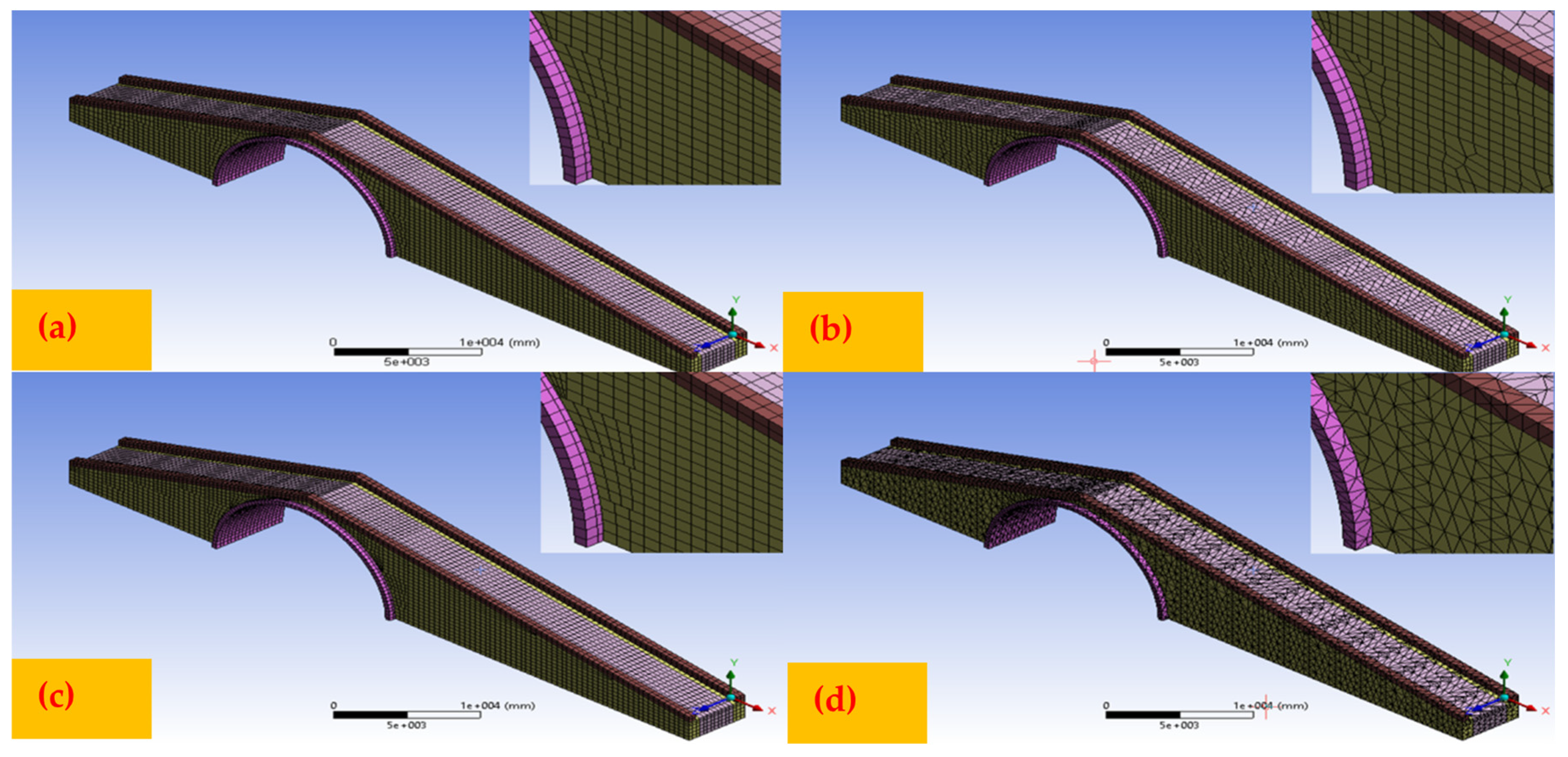
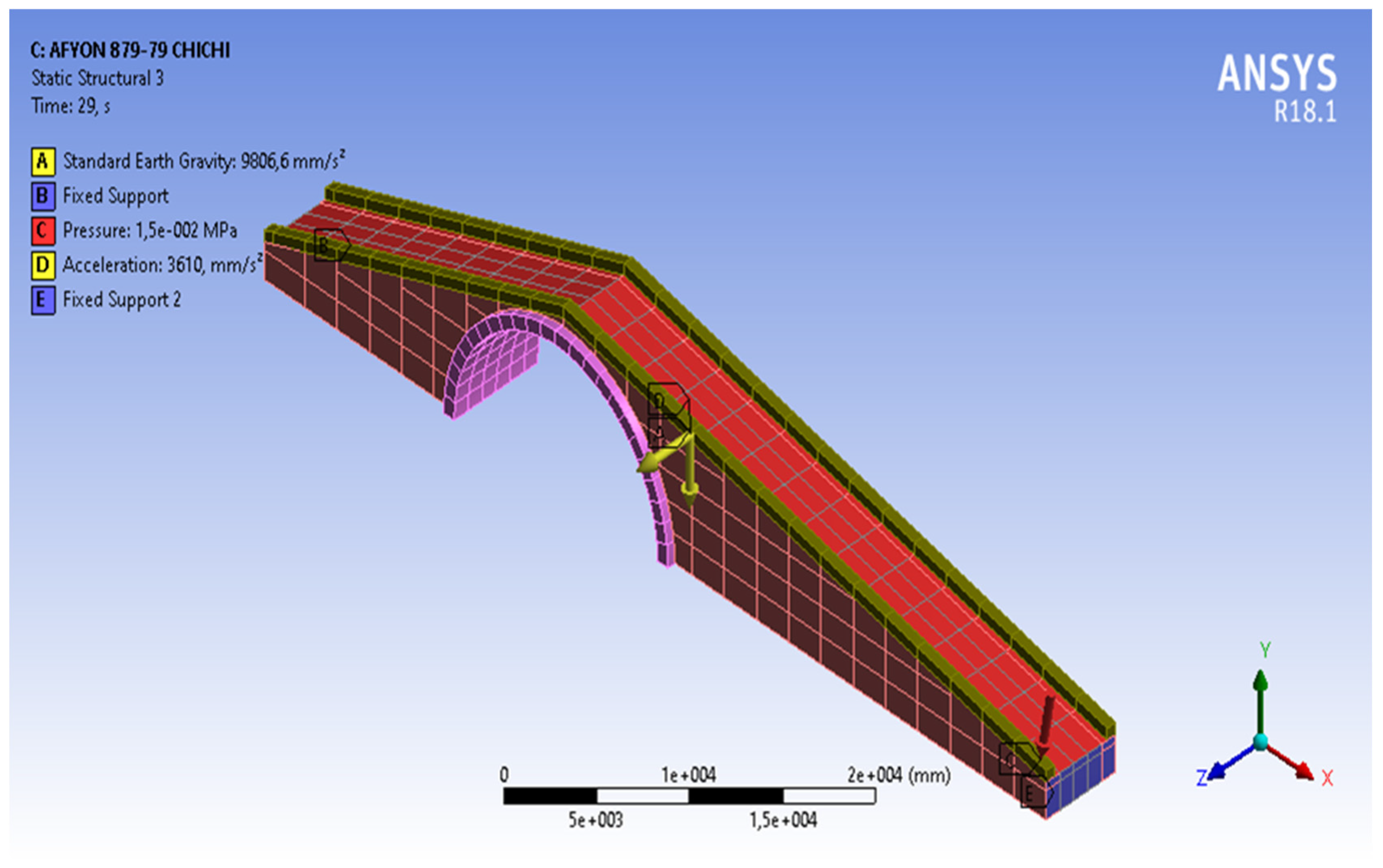
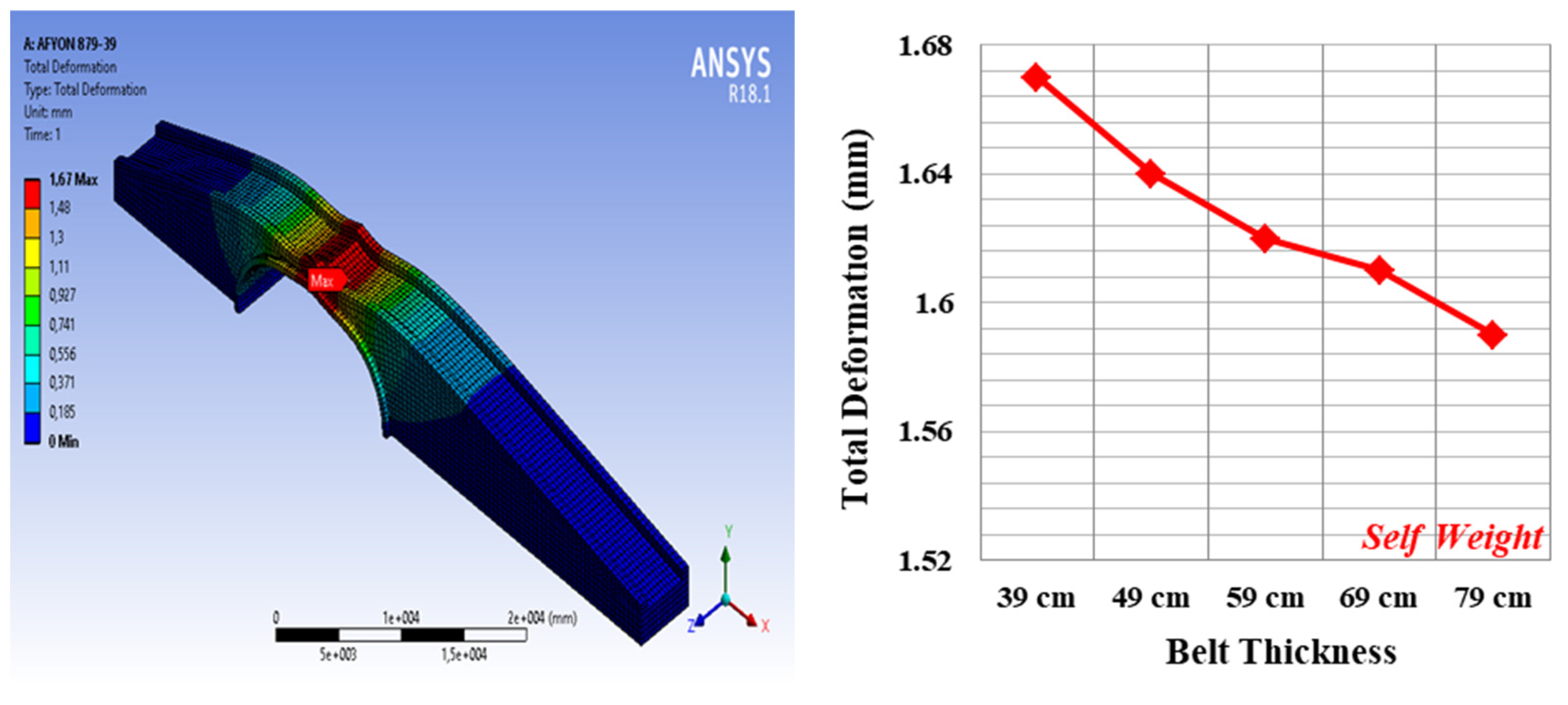
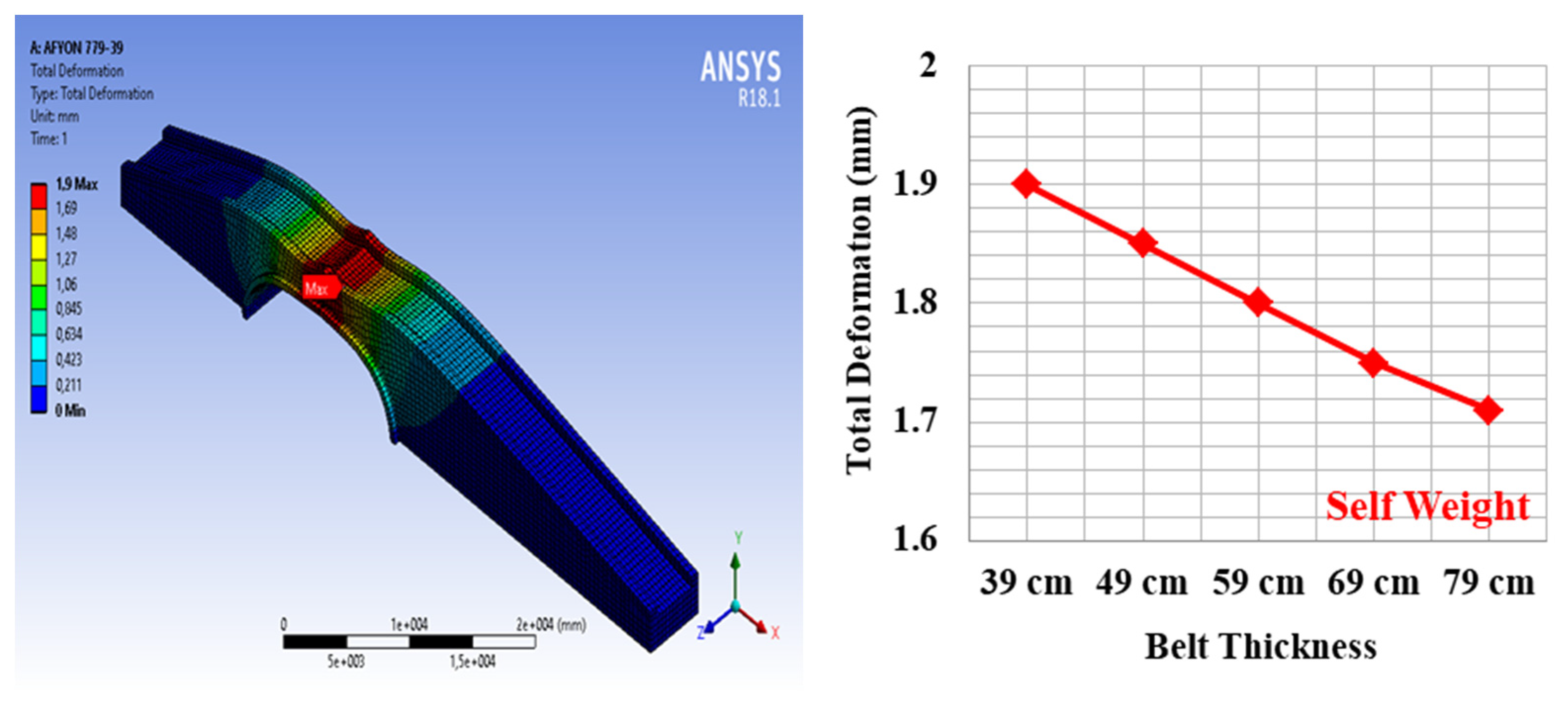


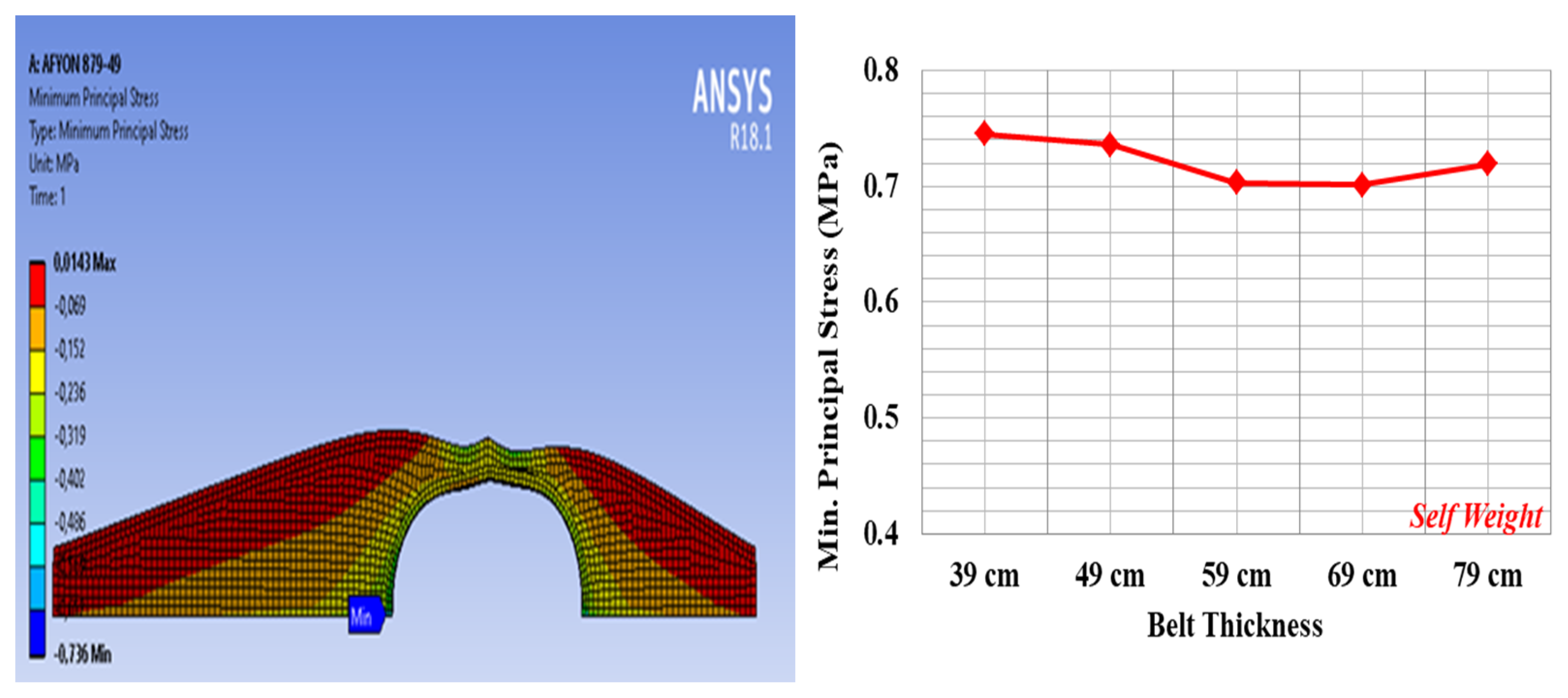
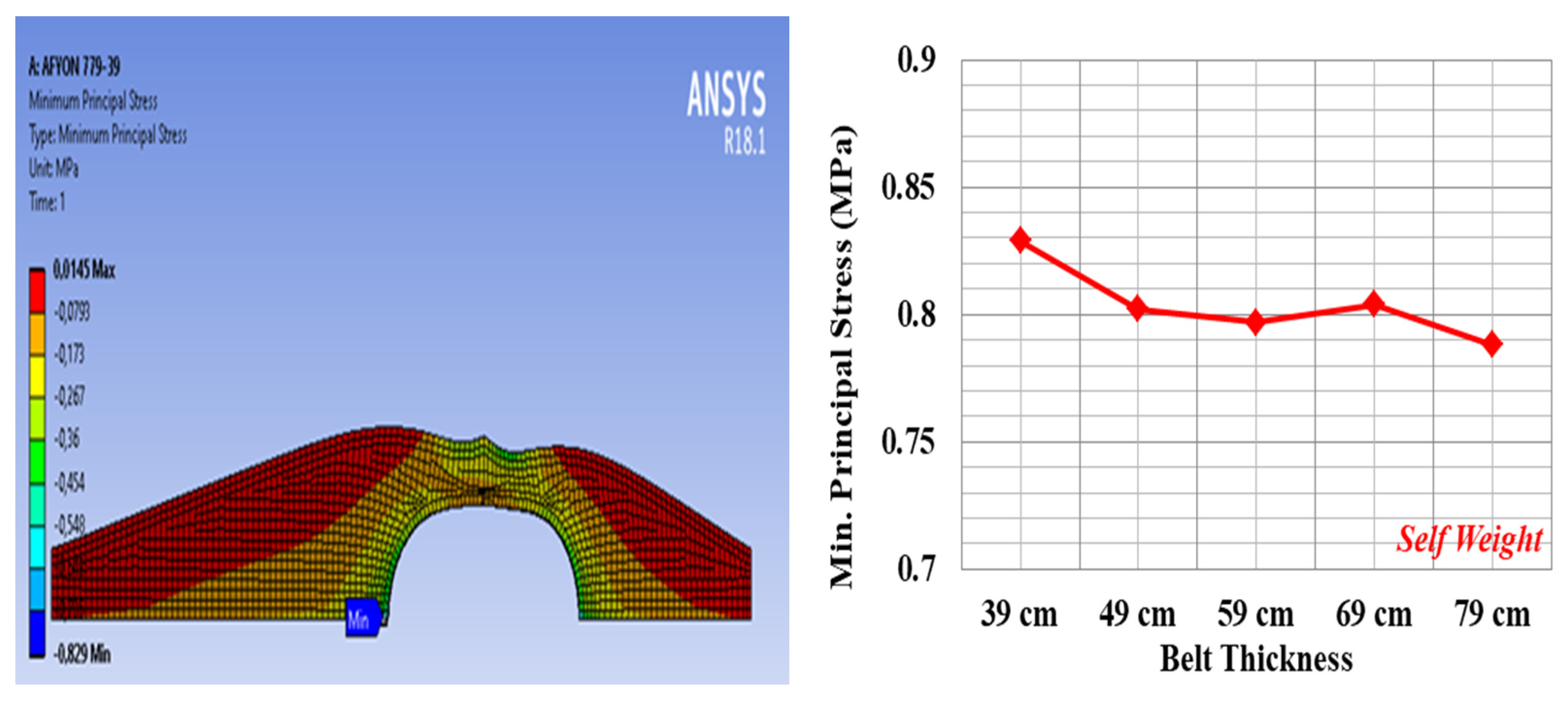



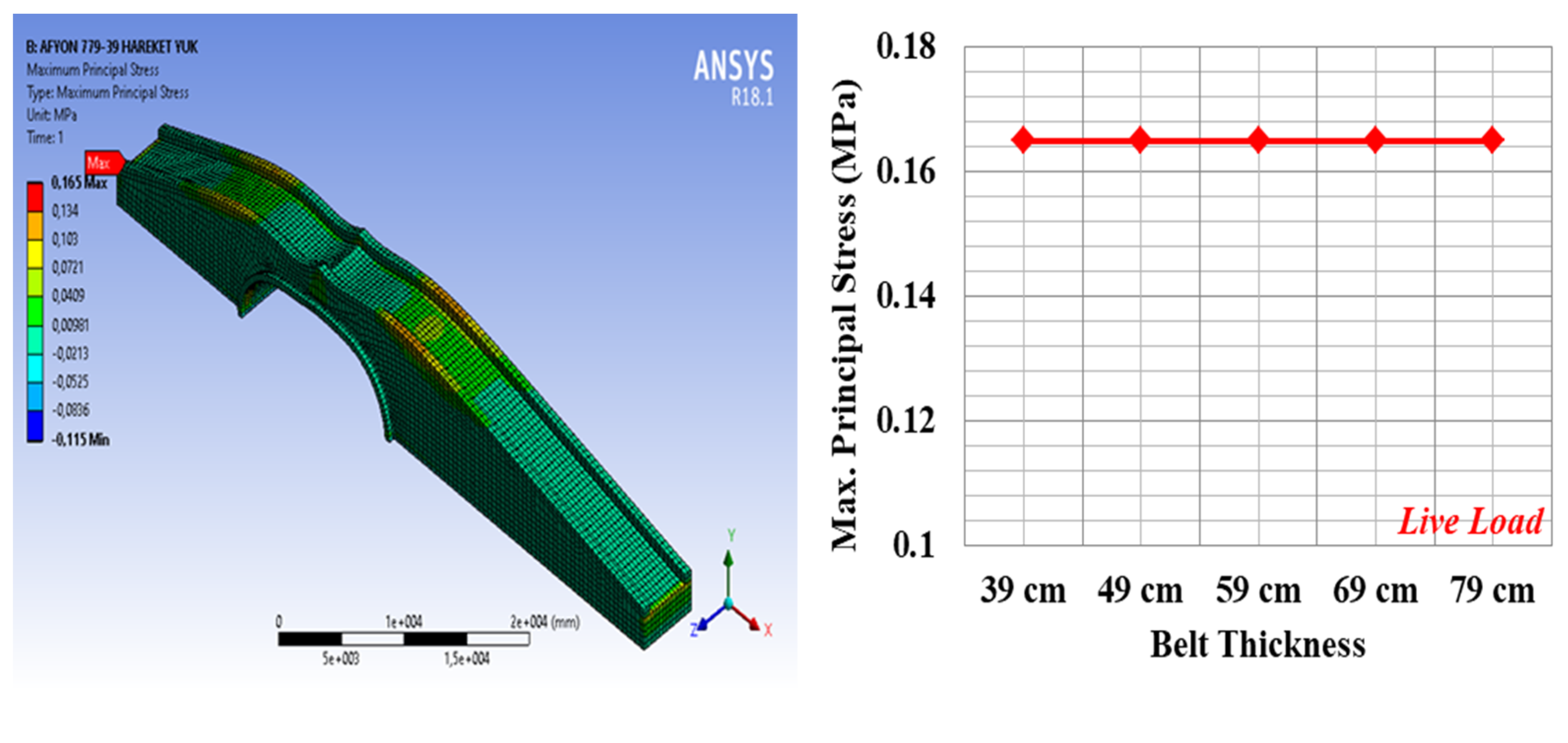
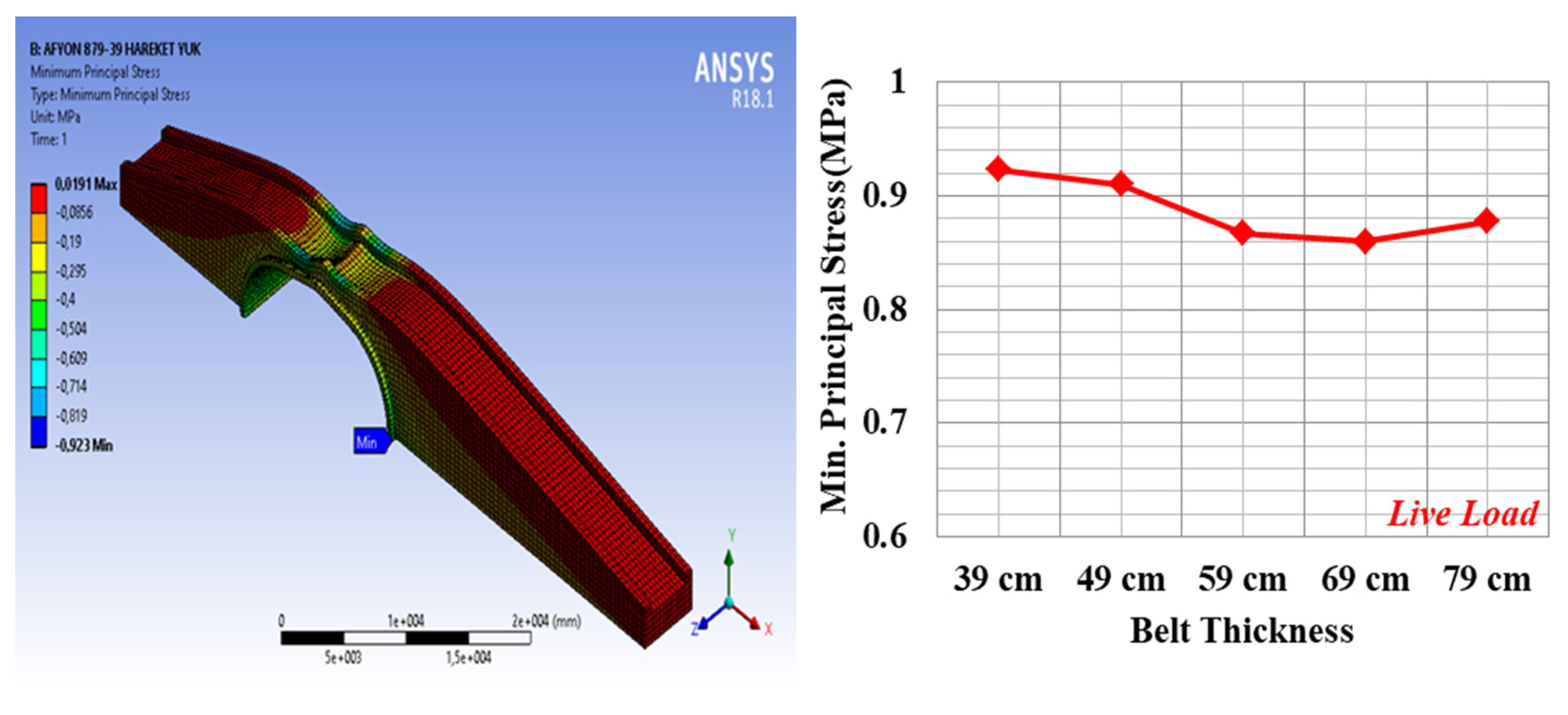
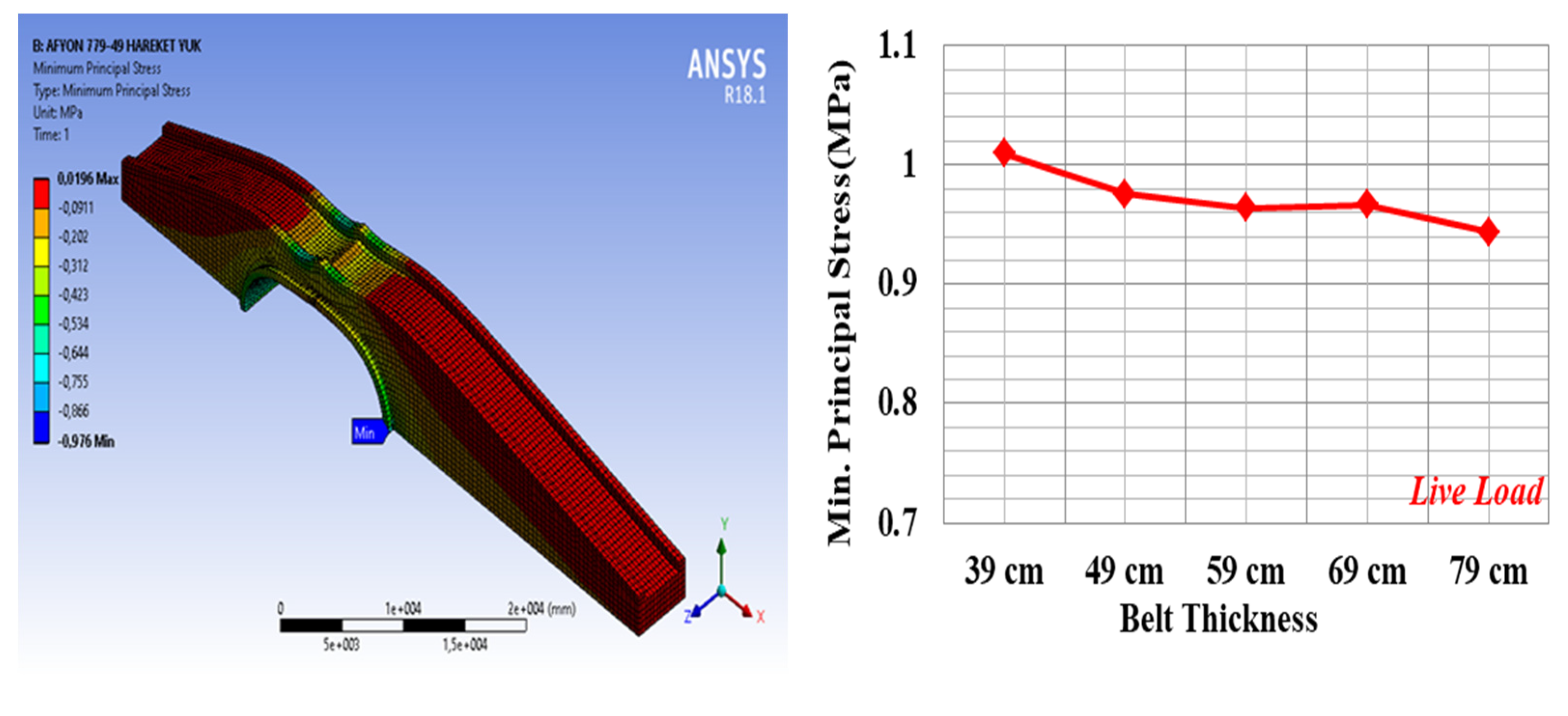
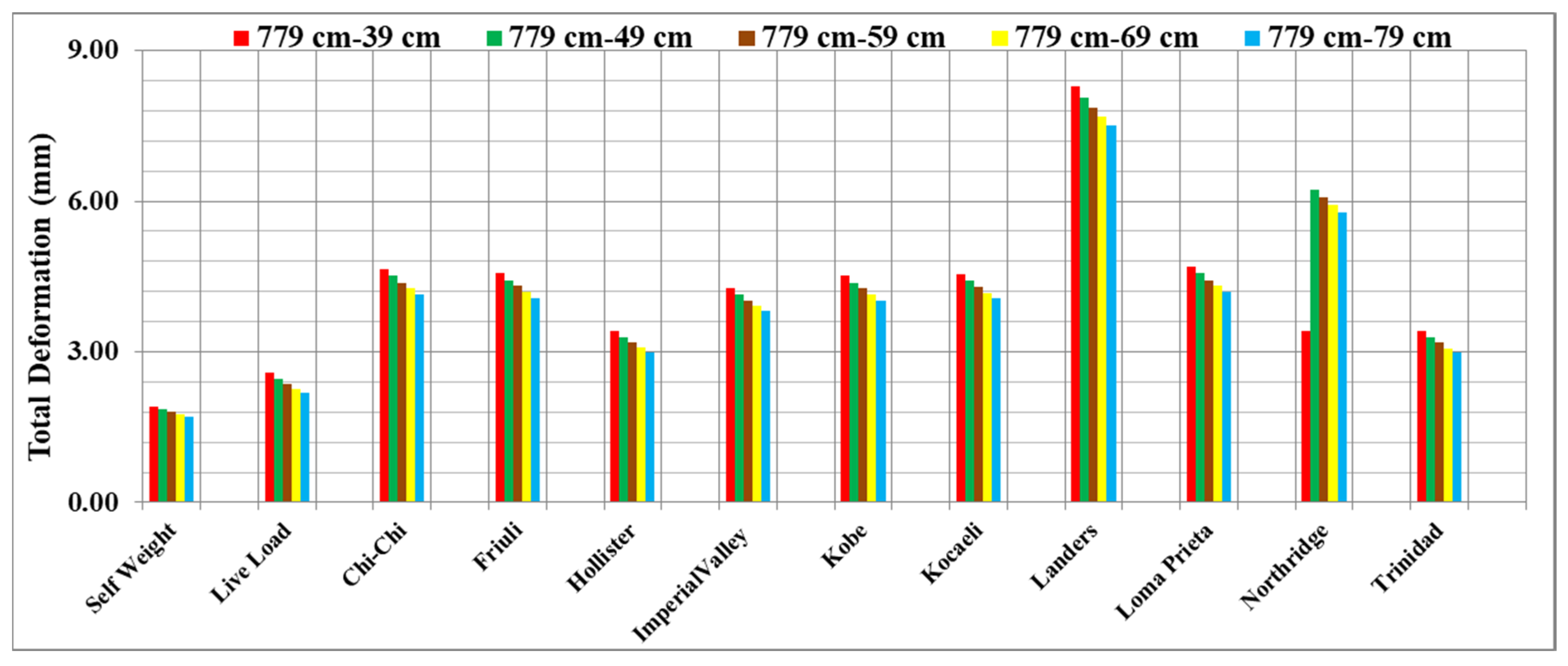

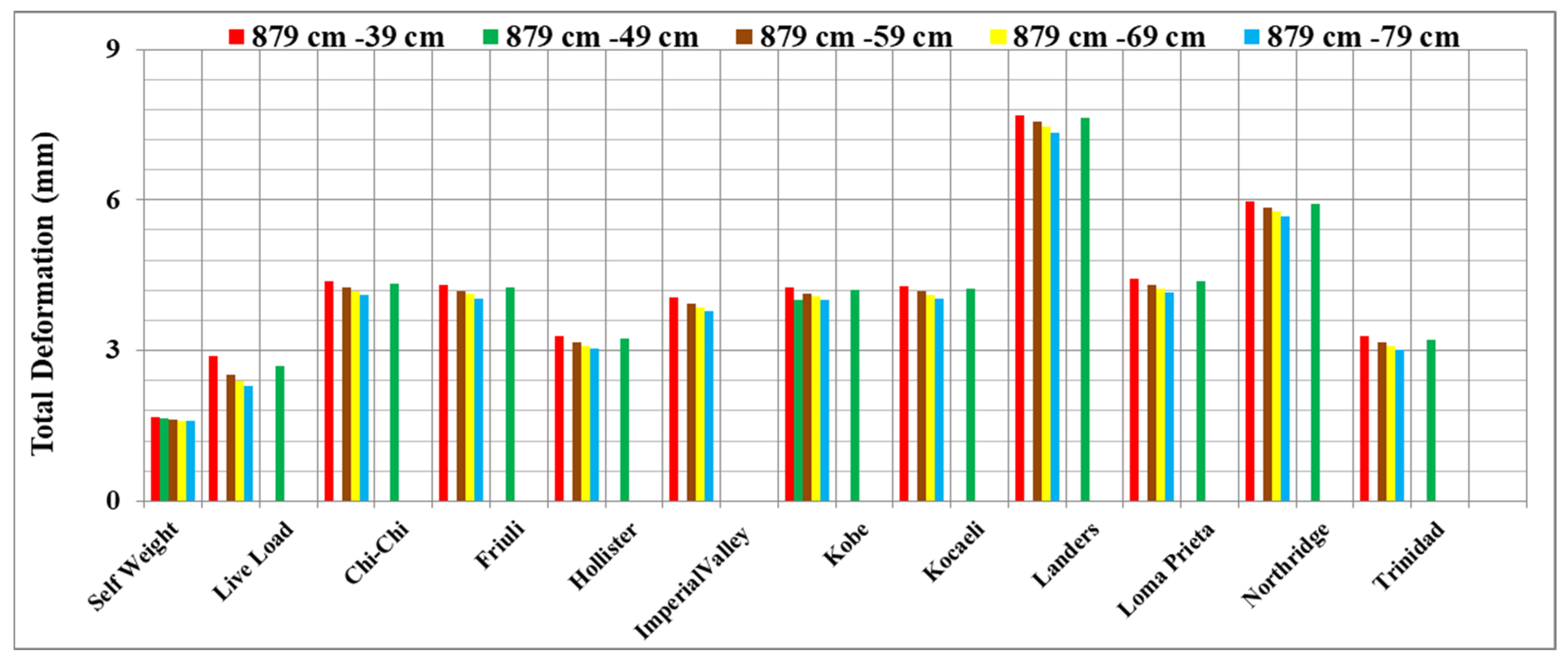
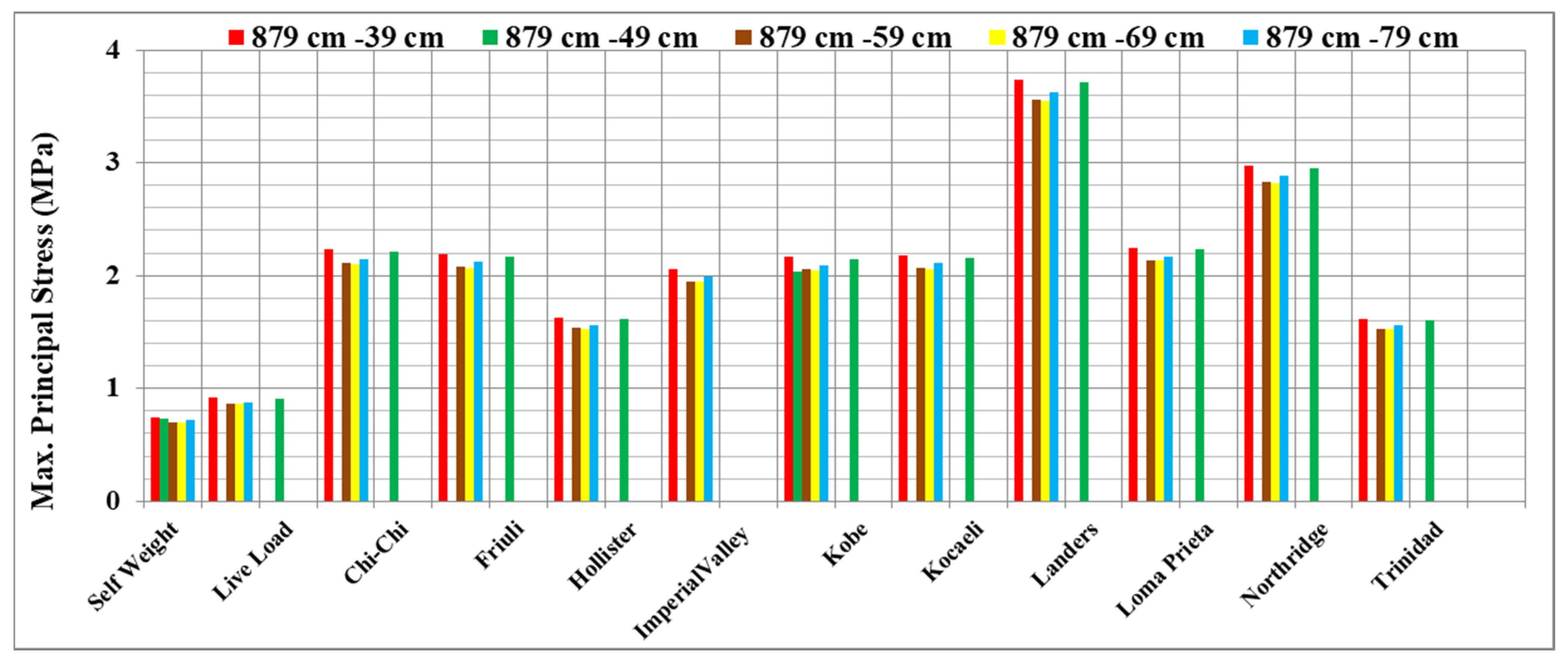
| İscehisar (Belt Height-Arch Thickness) | Automatic Method | HexDominant Method | Multizone Method | Tetrahedrons Method | |
|---|---|---|---|---|---|
| İscehisar (879 cm–79 cm) | Nodes | 150,906 | 155,176 | 161,029 | 116,767 |
| Elements | 20,942 | 29,588 | 22,681 | 46,565 | |
| İscehisar (879 cm–69 cm) | Nodes | 151,308 | 153,363 | 160,783 | 115,745 |
| Elements | 20,966 | 29,871 | 22,645 | 46,043 | |
| İscehisar (879 cm–59 cm) | Nodes | 151,308 | 152,411 | 160,783 | 116,204 |
| Elements | 20,996 | 28,957 | 22,645 | 46,334 | |
| İscehisar (879 cm–49 cm) | Nodes | 143,244 | 144,202 | 152,563 | 112,705 |
| Elements | 19,700 | 27,538 | 21,331 | 44,843 | |
| İscehisar (879 cm–39 cm) | Nodes | 143,172 | 144,770 | 152,827 | 111,985 |
| Elements | 19,664 | 27,134 | 21,349 | 44,156 | |
| İscehisar (779 cm–79 cm) | Nodes | 159,299 | 158,501 | 167,283 | 118,616 |
| Elements | 22,282 | 31,033 | 23,683 | 47,326 | |
| İscehisar (779 cm–69 cm) | Nodes | 159,149 | 159,019 | 167,208 | 119,457 |
| Elements | 22,252 | 31,420 | 23,668 | 47,814 | |
| İscehisar (779 cm–59 cm) | Nodes | 159,971 | 160,565 | 167,775 | 120,596 |
| Elements | 22,390 | 31,702 | 23,755 | 48,322 | |
| İscehisar (779 cm–49 cm) | Nodes | 152,489 | 152,800 | 159,987 | 116,880 |
| Elements | 21,184 | 30,249 | 22,501 | 46,625 | |
| İscehisar (779 cm–39 cm) | Nodes | 151,997 | 150,210 | 159,906 | 115,122 |
| Elements | 21,112 | 28,821 | 22,498 | 46,625 |
| Earthquake | Station | Magnitude (Mw) | Depth (km) | PGA (g) | PGV (cm/s) | PGD (cm) | PGV/ PGA (cm) |
|---|---|---|---|---|---|---|---|
| Chi-Chi, 1999 | TCU045 | 7.62 | 8 | 0.361 | 21.548 | 21.883 | 0.061 |
| Friuli, 1976 | Tolmezzo (000) | 6.50 | 5.1 | 0.351 | 22.020 | 4.067 | 0.064 |
| Hollister, 1961 | Hollister City Hall | 5.60 | 7.4 | 0.195 | 12.355 | 4.300 | 0.065 |
| İmperial Valley, 1979 | El Centro Array#2 | 6.53 | 9.96 | 0.315 | 31.496 | 14.126 | 0.102 |
| Kobe, 1995 | Kakogawa | 6.90 | 17.9 | 0.345 | 27.678 | 9.694 | 0.082 |
| Kocaeli 1999 | Yarımca | 7.51 | 16 | 0.349 | 62.182 | 51.302 | 0.182 |
| Landers, 1992 | Coolwater | 7.28 | 7 | 0.780 | 31.598 | 16.501 | 0.041 |
| Loma Prieta, 1989 | Gilroy Array #3 | 6.93 | 17.48 | 0.367 | 44.695 | 19.615 | 0.124 |
| Northridge, 1994 | Castaic-Old Ridge Route | 6.69 | 17.5 | 0.568 | 51.827 | 9.035 | 0.093 |
| Trinidad, 1983 | Rio Dell Overpass | 7.20 | 15.1 | 0.194 | 8.464 | 0.888 | 0.045 |
Disclaimer/Publisher’s Note: The statements, opinions and data contained in all publications are solely those of the individual author(s) and contributor(s) and not of MDPI and/or the editor(s). MDPI and/or the editor(s) disclaim responsibility for any injury to people or property resulting from any ideas, methods, instructions or products referred to in the content. |
© 2023 by the authors. Licensee MDPI, Basel, Switzerland. This article is an open access article distributed under the terms and conditions of the Creative Commons Attribution (CC BY) license (https://creativecommons.org/licenses/by/4.0/).
Share and Cite
Karalar, M.; Çufalı, G. Structural Assessment of Historical Stone Bridges with the Finite Element Method under Dynamic Effects of Arch Shape: The Antik Iscehisar Bridge. Appl. Sci. 2023, 13, 10740. https://doi.org/10.3390/app131910740
Karalar M, Çufalı G. Structural Assessment of Historical Stone Bridges with the Finite Element Method under Dynamic Effects of Arch Shape: The Antik Iscehisar Bridge. Applied Sciences. 2023; 13(19):10740. https://doi.org/10.3390/app131910740
Chicago/Turabian StyleKaralar, Memduh, and Gülşah Çufalı. 2023. "Structural Assessment of Historical Stone Bridges with the Finite Element Method under Dynamic Effects of Arch Shape: The Antik Iscehisar Bridge" Applied Sciences 13, no. 19: 10740. https://doi.org/10.3390/app131910740





